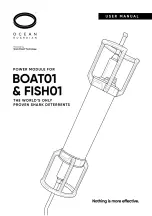
Commissioning
OPERATION MANUAL
Chapter 2
Unistat® T300 Series
Liability for errors and misprints excluded.
V1.2.0en/12.05.15//14.06
26
To enable your application to be operated correctly and eliminate air bubbles from the system, you
must ensure that the
>Circulation flow<
[1] connection from the temperature control unit is at-
tached to the lower connection point of the application and the
>Circulation return<
[2] into the
temperature control unit is attached to the higher connection point of the application.
PROCEDURE
Remove the screw plugs from the
>Circulation flow<
[1] and
>Circulation return<
[2] connec-
tions.
Then connect your application to the temperature control unit using suitable thermal fluid hoses.
The corresponding wrench sizes can be found in the table on page 22 in section
.
Check the connections for leaks.
2.10.2
Connecting an externally open application (bath)
Operating an externally open system without >Isolating sleeve< [27] installed
BURNS/FREEZING DUE TO OVERFLOWING EXPANSION VESSEL
Prior to starting up the temperature control unit with an externally open system, install the
>Isolating sleeve<
[27] (see page 24 in section
»Mounting/removing the isolating sleeve (op-
).
Close the
>Venting valve expansion vessel<
[21] for all stand-alone units by turning them
clockwise (turn 90° right as far as it will go).
To enable your application to be operated correctly and eliminate air bubbles from the system, you
must ensure that the
>Circulation flow<
[1] connection from the temperature control unit is at-
tached to the lower connection point [B] of the application and the
>Circulation return<
[2] connec-
tion is attached to the higher connection point [A] of the application. Make sure that the connection
point [B] of the application is at the same level or slightly higher than the connection
>Circulation
return<
[2].
PROCEDURE
Remove the screw plugs from the
>Circulation flow<
[1] and
>Circulation return<
[2] connec-
tions.
Then connect your application to the temperature control unit using suitable thermal fluid hoses.
The corresponding wrench sizes can be found in the table on page 22 in section
.
Check the connections for leaks.
2.11
Connecting to the power supply
Based on local circumstances, it may be that you need to use an alternative power cable instead of
the supplied original power cable. Do not use a power cable that is longer than
3 m
to be able to
disconnect the temperature control unit at any time from the mains. Have the mains cable only
replaced by a qualified electrician.
2.11.1
Connection using socket with protective earth (PE)
Connecting to a power socket without protective earth (PE)
MORTAL DANGER FROM ELECTRIC SHOCK
Always connect the temperature control unit to safety sockets (PE).
Example: Connecting
an externally open
application
















































